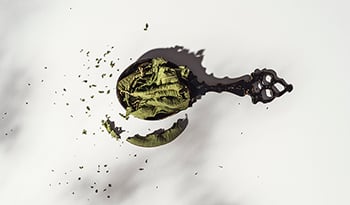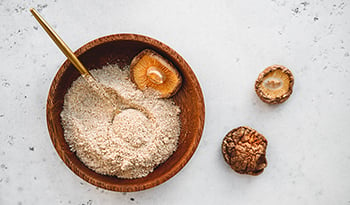Fo-Ti (Hé Shǒu Wū): Benefits, Hair Health, Immune Support, and More
DISCLAIMER:This blog does not intend to provide diagnosis...
- In this article:
- Brief History of Traditional Chinese Medicine
- What Is Fo-Ti?
- Differing Qualities of Raw Versus Prepared Fo-Ti
- Legend of Fo-Ti and Hair Health
- Health Benefits Fo-Ti
- Safety and Usage

Brief History of Traditional Chinese Medicine
Early Chinese Medicine has its roots in the shamanistic time of the Shang Dynasty around the 16th century BC. It was essentially demonological, attributing diseases and illnesses to the invisible forces of ancestors and gods.
In the Spring and Autumn Period of the Zhou dynasty (770-446 BC), Chinese culture flourished and well-known philosophers and poets, including Confucius, Lao-Tzu, Mo Ti, and Tao Chien, emerged. At this time, philosophy and science overlapped to explain illnesses in terms of natural occurrences in the world. The many philosophies and schools of thought born during this time are referred to as the “Hundred Schools of Thought.” Two of them are Confucianism and Taoism.
Traditional Chinese Medicine (TCM) was modernized and systematized during the Zhou dynasty. The Yin and Yang Theory, Five Element Theory, and other foundational theories that form the basis of TCM were established during this time.
The earliest Chinese Medical text on the theoretical systematic medicine of TCM is the Huáng Dì Nèi Jīng, or The Yellow Emperor’s Classic of Internal Medicine. It dates back to the second or first century BC.
Other texts, such as the Shén Nóng Běn Cǎo Jīng (Divine Husbandman’s Classic of Materia Medica), Shēng Hán Lùn (Discussion of Cold Damage), and Jīn Guì Yào Lüè (Essentials from the Golden Cabinet), were probably compiled and written by the third century. These and other famous classical Chinese medical texts are still taught to modern TCM college students worldwide.
Traditional Chinese Medicine (TCM) is a complete system of medicine comprised of eight branches: Acupuncture, Herbal Medicine, Nutrition, Body Work (Tui Na/Cupping/Moxibustion), Meditation, Tai Qi/Qi Gong (Exercise), Feng Shui, and Cosmology. TCM looks to the natural world and observes how human health and disease are subject to the principles of natural order.
In TCM, patterns of illness may arise in the body, organs, and meridians in various ways. If the organs and channel meridians that carry the “energy” or “Qi” are stagnated, deficient, or in excess, disease arises. Through special diagnostic methods, the TCM physician provides a diagnosis, prescription, and treatment plan encompassing the branches of TCM to the patient.
The Chinese farmer Shén Nóng is said to be the originator of Chinese Herbal Medicine. Around 6000 years ago, Shén Nóng invented the cart and plow and apparently discovered tea by accident. It is said that he cataloged 365 species of medicinal plants, which became known as the medical text Shén Nóng Běn Cǎo Jīng, or The Divine Husbandman’s Classic of Materia Medica.
What Is Fo-Ti?
Fo-ti is one of the most popular traditional Chinese medicines and is included in many preparations and prescriptions. It has been used for centuries in China to treat various diseases commonly associated with aging. Of the hundreds of prescriptions containing fo-ti, many are patented.
The botanical name for this ancient Chinese herb is Polygonum multiflorum. It is also known as fleeceflower root, flowery knotweed root, and, in Chinese, Hé Shǒu Wū. It first appeared in the text Materia Medica of Rì Huá-Zǐ from the 10th century.
This plant is cultivated in many provinces of China and Japan. Fo-ti grows in valley shrubs, forests, and rock crevices between 200 to 3000 meters in altitude. It is a fast-growing vine that has recently started growing in the West.
Fo-ti is typically used in one of two ways—in its prepared (stewed or steamed) or raw form. It has different actions and indications when used in these various forms.
Differing Qualities of Raw Versus Prepared Fo-Ti
In TCM, the flavors of herbs are associated with different qualities. Prepared Fo-ti, or Zhì Hé Shǒu Wū, is sweet, bitter, astringent, and slightly warm. Its main therapeutic actions affect the Liver and Kidney organs and meridians.
Fo-ti is considered a nourishing herb. It nourishes blood, yin, and preserves the essence. Fo-ti is used when there is a pattern of deficiency of yin or blood with symptoms of dizziness, tinnitus, premature graying of the hair, soreness of the back or knees, blurred vision, insomnia, and constipation. Fo-ti strengthens the bones, ligaments, and tendons.
The unprepared, raw form of Fo-ti, or Shēng Hé Shǒu Wū, is bitter, sweet, astringent, and neutral. It enters the Liver, Heart, and Large Intestine channels. It moistens the intestines, resolves toxicity, reduces sores, boils, abscesses, goiter, and scrofula (a condition that causes tuberculosis), and is used for malarial disorders. The stalk and leaves are used for insomnia and to treat various skin diseases and itching. In TCM, the raw form of Fo-ti is used for fire and toxicity.
This article focuses on the benefits of prepared Fo-ti or Zhì Hé Shǒu Wū.
Legend of Fo-Ti and Hair Health
The Chinese name of Fo-ti, Hé Shǒu Wū, literally translates to “Hé’s Black Hair.” An old legend tells of General Hé, who was convicted of a serious crime and sentenced to confinement and death in a remote cell dug into the ground without food or water.
After a year in confinement, his executioners returned to his cell to remove his remains for burial. They were surprised to find that not only had General Hé not died, but he was rejuvenated. Even his hair had regained its standard dark color. Without food or water, General Hé was forced to eat an exclusive diet of a vinelike herb that invaded the crevices of his cell. The herb was named Hé Shǒu Wū in remembrance of General Hé’s survival and physical rejuvenation.
Another story reported by Li Ao in 813 AD describes how the properties of Hé Shǒu Wū restored the sexual potency of a man. It allowed him to father a son, regain his standard hair color, and live to the age of 160 years.
While both stories are unsubstantiated, they attest to the rejuvenating properties of Hé Shǒu Wū.
Health Benefits Fo-Ti
Enhanced Insulin and Weight Management Effects
Research suggests that Fo-ti may help with weight management and associated metabolic diseases.
There are two types of fat tissue in the human body—white fat and brown fat. Brown fat plays a role in regulating energy metabolism in the body. It breaks down blood sugar, also known as glucose, to create heat and maintain body temperature. White fat is non-thermogenic, meaning it doesn’t create heat. White fat is more abundant in the body and more challenging to eliminate when losing weight.
In one study of mice with obesity, fo-ti suppressed the formation of white fat tissue and normalized lipid metabolism in brown fat tissue.
In another animal study, mice were fed a high-fat diet and a hot water extract of Fo-ti or garcinia cambogia for 12 weeks. Those that consumed Fo-ti extract gained less weight and body fat and had less insulin resistance than mice fed a high-fat diet without taking Fo-ti. They also experienced changes in lipid metabolism-related gene expressions in white and brown adipose tissue.
Scientists believe the flavones, quinones, phospholipids, and stilbenes in Fo-ti may be responsible for its health benefits.
Anti-Aging and Neuroprotective Effects
It turns out Fo-ti’s anti-aging benefits aren’t just legend. Fo-ti may offer neuroprotective effects, like enhanced learning and memory. Its many chemical compounds and antioxidants may help treat Alzheimer’s and Parkinson’s disease. Fo-ti may also promote hair growth.
Liver Support
Studies suggest Fo-ti may help regenerate the liver and inhibit the growth of activated stellate cells, which lead to liver cirrhosis. Because of this, it may be useful in treating liver damage and modulating liver inflammation from pharmaceutical use.
Immune System Support and Anti-Platelet Activity
Fo-ti may help regulate the immune system. Studies suggest Fo-ti increases the production of T cells that fight infection and B cells that create antibodies.
This herb also offers anti-inflammatory effects for the colon and may help those with colitis.
Kidney Support
Fo-ti may help improve kidney function in people with diabetic nephropathy. Diabetic nephropathy can lead to kidney failure or end-stage renal disease.
Safety and Usage
Fo-ti is generally safe for long-term consumption. People with diarrhea or phlegm conditions associated with spleen deficiency should avoid using Fo-ti.
As with all herbs and supplements, consult your physician, or a Nationally Board Certified Licensed Acupuncturist/Traditional Chinese Medicine Herbalist before trying Fo-ti to ensure it won’t interact with other medications you are taking.
References:
- Choi, Ra-Yeong, and Mi-Kyung Lee. Polygonum multiflorum Thunb. Hot Water Extract Reverses High-Fat Diet-Induced Lipid Metabolism of White and Brown Adipose Tissues in Obese Mice. Plants (Basel, Switzerland) vol. 10,8 1509. 23 Jul. 2021, doi:10.3390/plants10081509
- Lin L, Ni B, Lin H, et al. Traditional usages, botany, phytochemistry, pharmacology and toxicology of Polygonum multiflorum Thunb.: a review. J Ethnopharmacol. 2015;159:158-183. doi:10.1016/j.jep.2014.11.009
- Bensky D, Clavey S, Stoger E, Bensky LL. (2015). Chinese Herbal Medicine Materia Medica 3rd edition. Eastland Press.
- Tierra M, Tierra L. (1998). Chinese Traditional Herbal Medicine Vol II Materia Medica and Herbal Resource. Lotus Press.

 By Dr. Jayne Dabu, DAOM, L.Ac.
By Dr. Jayne Dabu, DAOM, L.Ac.


